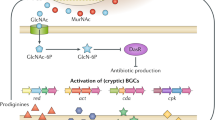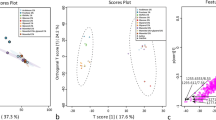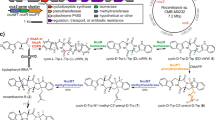Abstract
Actin-targeting macrolides comprise a large, structurally diverse group of cytotoxins isolated from remarkably dissimilar micro- and macroorganisms. In spite of their disparate origins and structures, many of these compounds bind actin at the same site and exhibit structural relationships reminiscent of modular, combinatorial drug libraries. Here we investigate biosynthesis and evolution of three compound groups: misakinolides, scytophycin-type compounds and luminaolides. For misakinolides from the sponge Theonella swinhoei WA, our data suggest production by an uncultivated 'Entotheonella' symbiont, further supporting the relevance of these bacteria as sources of bioactive polyketides and peptides in sponges. Insights into misakinolide biosynthesis permitted targeted genome mining for other members, providing a cyanobacterial luminaolide producer as the first cultivated source for this dimeric compound family. The data indicate that this polyketide family is bacteria-derived and that the unusual macrolide diversity is the result of combinatorial pathway modularity for some compounds and of convergent evolution for others.
This is a preview of subscription content, access via your institution
Access options
Subscribe to this journal
Receive 12 print issues and online access
$259.00 per year
only $21.58 per issue
Buy this article
- Purchase on Springer Link
- Instant access to full article PDF
Prices may be subject to local taxes which are calculated during checkout





Similar content being viewed by others
References
Allingham, J.S., Klenchin, V.A. & Rayment, I. Actin-targeting natural products: structures, properties and mechanisms of action. Cell. Mol. Life Sci. 63, 2119–2134 (2006).
Sasse, F., Steinmetz, H., Höfle, G. & Reichenbach, H. Rhizopodin, a new compound from Myxococcus stipitatus (myxobacteria) causes formation of rhizopodia-like structures in animal cell cultures. Production, isolation, physico-chemical and biological properties. J. Antibiot. 46, 741–748 (1993).
Ishibashi, M., Moore, R.E., Patterson, G.M.L., Xu, C.F. & Clardy, J. Scytophycins, cytotoxic and antimycotic agents from the cyanophyte Scytonema pseudohofmanni. J. Org. Chem. 51, 5300–5306 (1986).
Andrianasolo, E.H. et al. Isolation of swinholide A and related glycosylated derivatives from two field collections of marine cyanobacteria. Org. Lett. 7, 1375–1378 (2005).
Sakai, R., Higa, T. & Kashman, Y. Misakinolide A, an antitumor macrolide from the marine sponge Theonella sp. Chem. Lett. 15, 1499–1502 (1986).
D'Auria, M.V. et al. Reidispongiolide A and reidispongiolide B, 2 new potent cytotoxic macrolides from the New Caledonian sponge Reidispongia coerulea. Tetrahedron 50, 4829–4834 (1994).
Kernan, M.R. & Faulkner, D.J. Halichondramide, an antifungal macrolide from the sponge Halichondria sp. Tetrahedr. Lett. 28, 2809–2812 (1987).
Matsunaga, S., Fusetani, N., Hashimoto, K., Koseki, K. & Noma, M. Kabiramide C, a novel antifungal macrolide from nudibranch eggmasses. J. Am. Chem. Soc. 108, 847–849 (1986).
Guella, G., Mancini, I., Chiasera, G. & Pietra, F. Sphinxolide, a 26-membered antitumoral macrolide isolated from an unidentified Pacific nudibranch. Helv. Chim. Acta 72, 237–246 (1989).
Yamada, K. et al. Aplyronine A, a potent antitumor substance, and the congeners aplyronine B and aplyronine C isolated from the sea hare Aplysia kurodai. J. Am. Chem. Soc. 115, 11020–11021 (1993).
Rashid, M.A., Gustafson, K.R., Cardellina, J.H. & Boyd, M.R. Mycalolide D and mycalolide E, new cytotoxic macrolides from a collection of the stony coral Tubastrea faulkneri. J. Nat. Prod. 58, 1120–1125 (1995).
Kubanek, J. et al. Seaweed resistance to microbial attack: a targeted chemical defense against marine fungi. Proc. Natl. Acad. Sci. USA 100, 6916–6921 (2003).
Kitamura, M., Schupp, P.J., Nakano, Y. & Uemura, D. Luminaolide, a novel metamorphosis-enhancing macrodiolide for scleractinian coral larvae from crustose coralline algae. Tetrahedr. Lett. 50, 6606–6609 (2009).
Bewley, C.A. & Faulkner, D.J. Lithistid sponges: star performers or hosts to the stars. Angew. Chem. Int. Ed. 37, 2163–2178 (1998).
Piel, J. et al. Antitumor polyketide biosynthesis by an uncultivated bacterial symbiont of the marine sponge Theonella swinhoei. Proc. Natl. Acad. Sci. USA 101, 16222–16227 (2004).
Freeman, M.F. et al. Metagenome mining reveals polytheonamides as posttranslationally modified ribosomal peptides. Science 338, 387–390 (2012).
Wilson, M.C. et al. An environmental bacterial taxon with a large and distinct metabolic repertoire. Nature 506, 58–62 (2014).
Bewley, C.A., Holland, N.D. & Faulkner, D.J. Two classes of metabolites from Theonella swinhoei are localized in distinct populations of bacterial symbionts. Experientia 52, 716–722 (1996).
Schmidt, E.W., Obraztsova, A.Y., Davidson, S.K., Faulkner, D.J. & Haygood, M.G. Identification of the antifungal peptide-containing symbiont of the marine sponge Theonella swinhoei as a novel δ-proteobacterium, “Candidatus Entotheonella palauensis”. Mar. Biol. 136, 969–977 (2000).
Hertweck, C. The biosynthetic logic of polyketide diversity. Angew. Chem. Int. Ed. Engl. 48, 4688–4716 (2009).
Piel, J. Biosynthesis of polyketides by trans-AT polyketide synthases. Nat. Prod. Rep. 27, 996–1047 (2010).
Nguyen, T. et al. Exploiting the mosaic structure of trans-acyltransferase polyketide synthases for natural product discovery and pathway dissection. Nat. Biotechnol. 26, 225–233 (2008).
Piel, J. A polyketide synthase-peptide synthetase gene cluster from an uncultured bacterial symbiont of Paederus beetles. Proc. Natl. Acad. Sci. USA 99, 14002–14007 (2002).
Sudek, S. et al. Identification of the putative bryostatin polyketide synthase gene cluster from “Candidatus Endobugula sertula”, the uncultivated microbial symbiont of the marine bryozoan Bugula neritina. J. Nat. Prod. 70, 67–74 (2007).
Partida-Martinez, L.P. & Hertweck, C. Pathogenic fungus harbours endosymbiotic bacteria for toxin production. Nature 437, 884–888 (2005).
Fisch, K.M. et al. Polyketide assembly lines of uncultivated sponge symbionts from structure-based gene targeting. Nat. Chem. Biol. 5, 494–501 (2009).
Donia, M.S. et al. Complex microbiome underlying secondary and primary metabolism in the tunicate-Prochloron symbiosis. Proc. Natl. Acad. Sci. USA 108, E1423–E1432 (2011).
Hrvatin, S. & Piel, J. Rapid isolation of rare clones from highly complex DNA libraries by PCR analysis of liquid gel pools. J. Microbiol. Methods 68, 434–436 (2007).
Binga, E.K., Lasken, R.S. & Neufeld, J.D. Something from (almost) nothing: the impact of multiple displacement amplification on microbial ecology. ISME J. 2, 233–241 (2008).
Richter, M. & Rosselló-Móra, R. Shifting the genomic gold standard for the prokaryotic species definition. Proc. Natl. Acad. Sci. USA 106, 19126–19131 (2009).
Yang, J.Y. et al. Primer on agar-based microbial imaging mass spectrometry. J. Bacteriol. 194, 6023–6028 (2012).
Irschik, H. et al. Analysis of the sorangicin gene cluster reinforces the utility of a combined phylogenetic/retrobiosynthetic analysis for deciphering natural product assembly by trans-AT PKS. ChemBioChem 11, 1840–1849 (2010).
Teta, R. et al. Genome mining reveals trans-AT polyketide synthase directed antibiotic biosynthesis in the bacterial phylum Bacteroidetes. ChemBioChem 11, 2506–2512 (2010).
Pistorius, D. & Müller, R. Discovery of the rhizopodin biosynthetic gene cluster in Stigmatella aurantiaca Sg a15 by genome mining. ChemBioChem 13, 416–426 (2012).
Elshahawi, S.I. et al. Boronated tartrolon antibiotic produced by symbiotic cellulose-degrading bacteria in shipworm gills. Proc. Natl. Acad. Sci. USA 110, E295–E304 (2013).
Caffrey, P. Conserved amino acid residues correlating with ketoreductase stereospecificity in modular polyketide synthases. ChemBioChem 4, 654–657 (2003).
Reid, R. et al. A model of structure and catalysis for ketoreductase domains in modular polyketide synthases. Biochemistry 42, 72–79 (2003).
Keatinge-Clay, A. Crystal structure of the erythromycin polyketide synthase dehydratase. J. Mol. Biol. 384, 941–953 (2008).
Pöplau, P., Frank, S., Morinaka, B.I. & Piel, J. An enzymatic domain for the formation of cyclic ethers in complex polyketides. Angew. Chem. Int. Ed. Engl. 52, 13215–13218 (2013).
Carmeli, S., Moore, R.E. & Patterson, G.M.L. Tolytoxin and new scytophycins from 3 species of Scytonema. J. Nat. Prod. 53, 1533–1542 (1990).
O'Brien, R.V., Davis, R.W., Khosla, C. & Hillenmeyer, M.E. Computational identification and analysis of orphan assembly-line polyketide synthases. J. Antibiot. 67, 89–97 (2014).
Berkhan, G. & Hahn, F. A dehydratase domain in ambruticin biosynthesis displays additional activity as a pyran-forming cyclase. Angew. Chem. Int. Ed. Engl. 53, 14240–14244 (2014).
Wakimoto, T. et al. Calyculin biogenesis from a pyrophosphate protoxin produced by a sponge symbiont. Nat. Chem. Biol. 10, 648–655 (2014).
Kampa, A. et al. Metagenomic natural product discovery in lichen provides evidence for specialized biosynthetic pathways in diverse symbioses. Proc. Natl. Acad. Sci. USA 110, E3129–E3137 (2013).
Nakabachi, A. et al. Defensive bacteriome symbiont with a drastically reduced genome. Curr. Biol. 23, 1478–1484 (2013).
Jenke-Kodama, H., Sandmann, A., Müller, R. & Dittmann, E. Evolutionary implications of bacterial polyketide synthases. Mol. Biol. Evol. 22, 2027–2039 (2005).
Jenner, M. et al. Substrate specificity in ketosynthase domains from trans-AT polyketide synthases. Angew. Chem. Int. Ed. Engl. 52, 1143–1147 (2013).
Kohlhaas, C. et al. Amino acid-accepting ketosynthase domain from a trans-AT polyketide synthase exhibits high selectivity for predicted intermediate. Chem. Sci. 4, 3212–3217 (2013).
Jenner, M. et al. Acyl-chain elongation drives ketosynthase substrate selectivity in trans-acyltransferase polyketide synthases. Angew. Chem. Int. Ed. Engl. 54, 1817–1821 (2015).
Perrins, R.D., Cecere, G., Paterson, I. & Marriott, G. Synthetic mimetics of actin-binding macrolides: Rational design of actin-targeted drugs. Chem. Biol. 15, 287–294 (2008).
Garcia-Pichel, F. & Castenholz, R.W. Characterization and biological implications of scytonemin, a cyanobacterial sheath pigment. J. Phycol. 27, 395–409 (1991).
Gaget, V., Welker, M., Rippka, R. & de Marsac, N.T. A polyphasic approach leading to the revision of the genus Planktothrix (Cyanobacteria) and its type species, P. agardhii, and proposal for integrating the emended valid botanical taxa, as well as three new species, Planktothrix paucivesiculata sp. nov.ICNP, Planktothrix tepida sp. nov.ICNP, and Planktothrix serta sp. nov.ICNP, as genus and species names with nomenclatural standing under the ICNP. Syst. Appl. Microbiol. 38, 141–158 (2015).
Rippka, R., Deruelles, J., Waterbury, J.B., Herdman, M. & Stanier, R.Y. Generic assignments, strain histories and properties of pure cultures of cyanobacteria. J. Gen. Microbiol. 111, 1–61 (1979).
Spiegel, M. & Rubinstein, N.A. Synthesis of RNA by dissociated cells of sea urchin embryo. Exp. Cell Res. 70, 423–430 (1972).
Yilmaz, L.S., Pamerkar, S. & Noguera, D.R. mathFISH, a web tool that uses thermodynamics-based mathematical models for in silico evaluation of oligonucleotide probes for fluorescence in situ hybridization. Appl. Environ. Microbiol. 77, 1118–1122 (2011).
Schramm, A., Fuchs, B.M., Nielsen, J.L., Tonolla, M. & Stahl, D.A. Fluorescence in situ hybridization of 16S rRNA gene clones (Clone-FISH) for probe validation and screening of clone libraries. Environ. Microbiol. 4, 713–720 (2002).
Wetmur, J.G. DNA probes: applications of the principles of nucleic acid hybridization. Crit. Rev. Biochem. Mol. Biol. 26, 227–259 (1991).
Pernthaler, A., Pernthaler, J. & Amann, R. Fluorescence in situ hybridization and catalyzed reporter deposition for the identification of marine bacteria. Appl. Environ. Microbiol. 68, 3094–3101 (2002).
Watrous, J. et al. Mass spectral molecular networking of living microbial colonies. Proc. Natl. Acad. Sci. USA 109, E1743–E1752 (2012).
Acknowledgements
We thank T. Wakimoto and K. Takada for providing sponge samples, D. Uemura for a generous sample of luminaolide, M. Wilson for sequence analysis and naming of 'Entotheonella serta', C. Maufrais and A. Criscuolo from the Bioinformatic Plateform of the Institut Pasteur for help in ANI calculation, and J. Pernthaler for helpful discussion and for providing material for CARD-FISH experiments. We are also grateful to Y.I. Park and J.-F. Humbert for the use of cyanobacterial genomes. This work was funded by grants of the SNF (IZLSZ3_149025), and the EU (BlueGenics and BluePharmTrain) to J.P., by the Institut Pasteur to M.G., by an Alexander von Humboldt Research Fellowship to R.U. and by a DAAD fellowship to A.R.U.
Author information
Authors and Affiliations
Contributions
R.U. isolated and characterized polyketides from cyanobacteria, A.R.U. performed the genetic work on misakinolide, S.R. performed the phylogenetic studies, T.M. and H.T. conducted the single-cell experiments, P.K. expressed and assayed the misakinolide PS domain, B.I.M. characterized the PS product, E.E.P. conducted the CARD-FISH experiments, E.J.N.H. performed MS analysis including imaging, M.G. cultivated and sequenced cyanobacteria and performed ANI calculations, S.M. provided and analyzed sponge chemotypes, J.P. analyzed PKS sequences and predicted polyketide structures, all authors designed research, analyzed data and wrote the manuscript.
Corresponding author
Ethics declarations
Competing interests
The authors declare no competing financial interests.
Supplementary information
Supplementary Text and Figures
Supplementary Note, Supplementary Results, Supplementary Figures 1–26 and Supplementary Tables 1–6. (PDF 2339 kb)
Rights and permissions
About this article
Cite this article
Ueoka, R., Uria, A., Reiter, S. et al. Metabolic and evolutionary origin of actin-binding polyketides from diverse organisms. Nat Chem Biol 11, 705–712 (2015). https://doi.org/10.1038/nchembio.1870
Received:
Accepted:
Published:
Issue Date:
DOI: https://doi.org/10.1038/nchembio.1870



